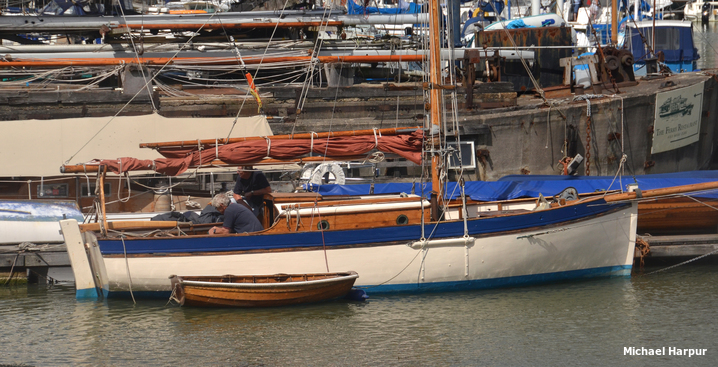
Elephant Boatyard is situated on the south coast of England, within the River Hamble that flows into the northeast side of Southampton Water. It is a traditional boatyard that occasionally accommodates visitors, and is situated in the upper end of a river that is a yachting centre of considerable importance.
Located within the protected waters of Southampton Waters and two and a half miles upriver, the boatyard offers complete protection. Although it can be safely accessed night or day, and at any state of the tide for most vessels, it is best that newcomers visit during daylight.

Keyfacts for Elephant Boatyard
Last modified
July 17th 2018 Summary
A completely protected location with safe access.Facilities




















Nature


Considerations


Position and approaches
Expand to new tab or fullscreen
Haven position
 50° 52.956' N, 001° 18.218' W
50° 52.956' N, 001° 18.218' WThis is the southernmost end of the hammerhead pontoon.
What are the key points of the approach?
The entry and the run-up thorough The Solent and Southampton Water are covered in
The Solent and Isle of Wight coastal description. The River Hamble and its approaches are detailed the Deacons Marina and Boatyard
coastal description. The River Hamble and its approaches are detailed the Deacons Marina and Boatyard  entry.
entry.
The Solent and Isle of Wight
 coastal description. The River Hamble and its approaches are detailed the Deacons Marina and Boatyard
coastal description. The River Hamble and its approaches are detailed the Deacons Marina and Boatyard  entry.
entry.Not what you need?
Click the 'Next' and 'Previous' buttons to progress through neighbouring havens in a coastal 'clockwise' or 'anti-clockwise' sequence. Below are the ten nearest havens to Elephant Boatyard for your convenience.
Ten nearest havens by straight line charted distance and bearing:
- Deacons Marina and Boatyard - 0 nautical miles NNE
- Swanwick Marina - 0.2 nautical miles SE
- Universal Marina - 0.5 nautical miles SSW
- Mercury Yacht Harbour - 0.7 nautical miles SSW
- Port Hamble Marina - 1.4 nautical miles SSW
- Hamble River Harbour Master - 1.8 nautical miles S
- Warsash Sailing Club - 1.9 nautical miles S
- Hamble Point Marina - 1.9 nautical miles S
- Netley - 2 nautical miles SW
- Saxon Wharf Marina - 3.3 nautical miles WNW
These havens are ordered by straight line charted distance and bearing, and can be reordered by compass direction or coastal sequence:
- Deacons Marina and Boatyard - 0 miles NNE
- Swanwick Marina - 0.2 miles SE
- Universal Marina - 0.5 miles SSW
- Mercury Yacht Harbour - 0.7 miles SSW
- Port Hamble Marina - 1.4 miles SSW
- Hamble River Harbour Master - 1.8 miles S
- Warsash Sailing Club - 1.9 miles S
- Hamble Point Marina - 1.9 miles S
- Netley - 2 miles SW
- Saxon Wharf Marina - 3.3 miles WNW
How to get in?
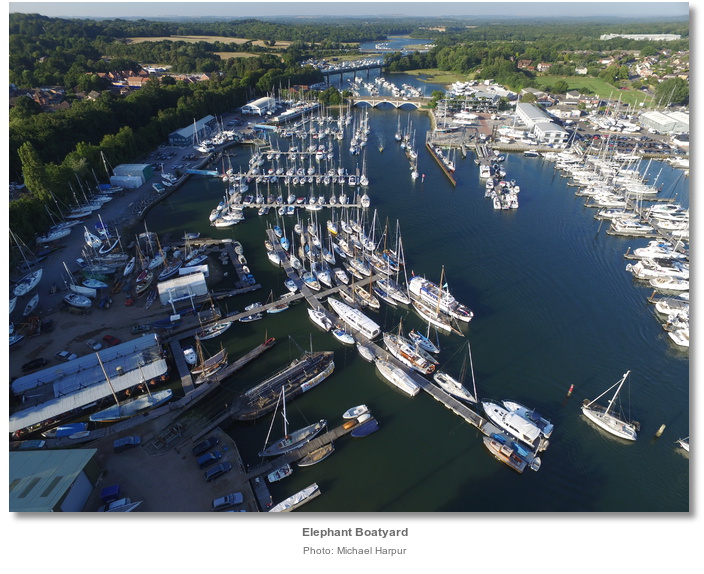
The Elephant Boatyard is a traditional boatyard that specialises in classic wooden yachts. It is situated on the upper reaches of the meandering Hamble River more than two miles above its entrance. The yard can be found on the west bank of the river about 250 metres below Bursledon Bridge. For most sailing craft Bursledon Bridge, with an air draught of 4 metres height (MHWS), marks the effective head of navigation.
The Elephant Boat Yard has no visitor berths and has no specific arrangements to receive visitors. However they do take visitors on an ad hoc basis if there is space available on their boatyard’s hammerhead. As it is entirely impromptu but competitively priced and sited in a wonderfully interesting part of the river, it is worth checking availability. The yard is only open during working- week hours, 9am to 5pm and can be contacted on P: +44 23 8040 3268.
The onsite floating Ferry Restaurant, most remarkably built into what was once the Woolston Floating Bridge, has been offering excellent food for over a decade to the boatyard patrons. Those intending on dining in the restaurant will be given priority when it comes to berths.
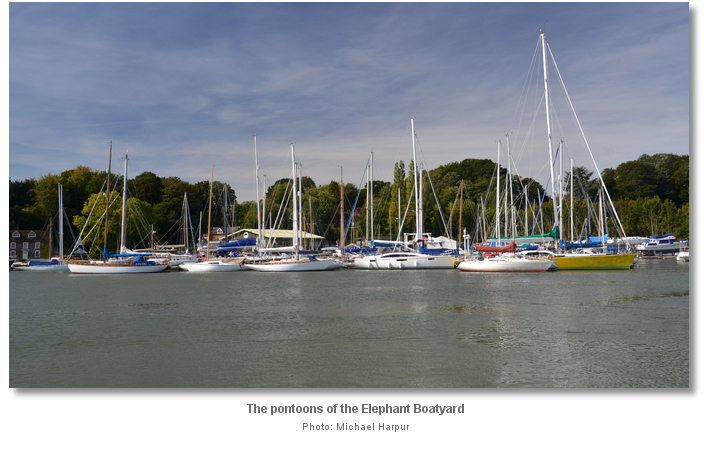
 The Solent and Isle of Wight
The Solent and Isle of Wight  coastal description provides approach details. Vessels navigating the six-mile length of Southampton Water should keep a listening watch for Southampton VTS, on VHF Ch 12/16, especially around the docks, and give priority to commercial traffic.
coastal description provides approach details. Vessels navigating the six-mile length of Southampton Water should keep a listening watch for Southampton VTS, on VHF Ch 12/16, especially around the docks, and give priority to commercial traffic.Vessels converging on the entrance will find nothing in the way of local hazards by staying in reasonable soundings and following the Solent’s ample marks. The entrance to the River Hamble is made known from a great distance by being almost opposite to Fawley Power Station in Southampton Water. Fawley's 198 metres high chimney makes a conspicuous mark throughout the central Solent and beyond.
The approaches and run up the river as far as the Bursledon Bridge, the effective head of navigation for most sailing craft, are covered in the Deacons Marina and Boatyard
 entry.
entry.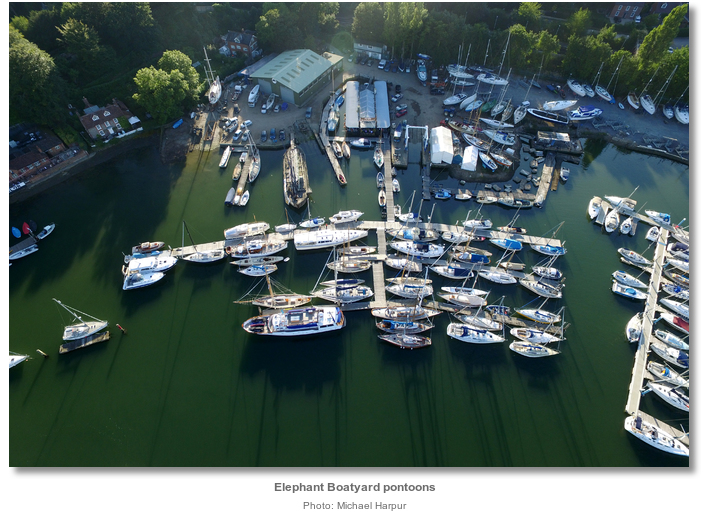
 Berth alongside the boatyard’s hammerhead as directed. As with all the River Hamble’s pontoons and jetties the helmsman should be mindful of the tide state when berthing at the Elephant Boatyard. This is especially the case on Springs when the ‘river effect’, of a very fast initial tidal drop, is amplified by the Solent’s double high ‘tidal stand’, that only provides the ebb 3 - 4 hours to complete its cycle. This creates a disproportionately sudden and strong ebb flush that requires particular attention from the helmsman.
Berth alongside the boatyard’s hammerhead as directed. As with all the River Hamble’s pontoons and jetties the helmsman should be mindful of the tide state when berthing at the Elephant Boatyard. This is especially the case on Springs when the ‘river effect’, of a very fast initial tidal drop, is amplified by the Solent’s double high ‘tidal stand’, that only provides the ebb 3 - 4 hours to complete its cycle. This creates a disproportionately sudden and strong ebb flush that requires particular attention from the helmsman.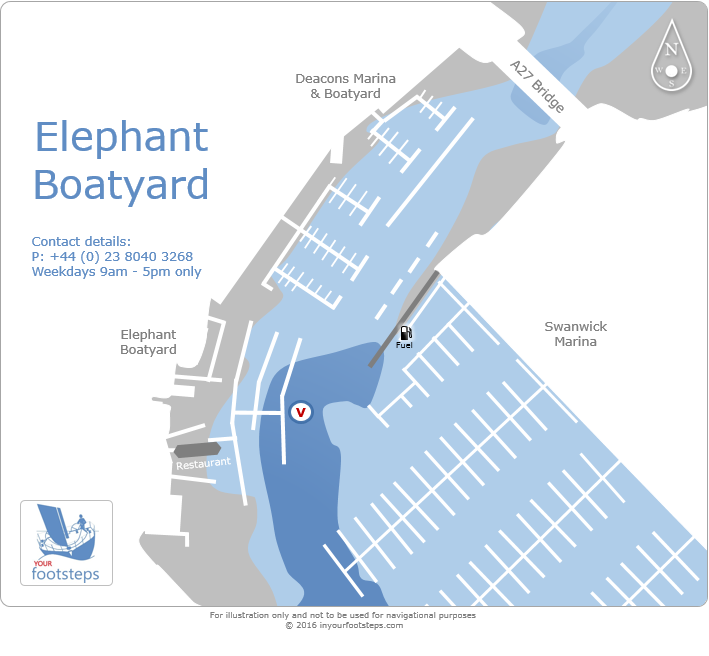
Why visit here?
Elephant Boat Yard received its name from the later 74-gun third-rate ship of the line of the Royal Navy HMS Elephant. She was built and launched from the boatyard in 1786, and the current boatyard which was founded by Michael Richardson in 1952 on the same site took on the ship’s name to mark the renowned ship’s birth place.Shipbuilding in the River Hamble however goes back many more centuries before HMS Elephant’s. The river’s sheltered waters, forested banks and ready access to the sea created ideal conditions for the construction of timber ships, and King Henry VIII's fleet was built here. The river’s shipbuilding heyday was in the time of HMS Elephant during the latter half of the 18th century and the beginning of the 19th. Then Elephant was one of forty-six ships that River Hamble provided to the navy during this period. After this the supply of shipbuilding timber began to run low around the river and much of the naval shipbuilding moved to Beaulieu and Lepe where the New Forrest provided a plentiful supply. By then the defeat of Napoleon at Waterloo and the subsequent lack of a French threat for the subsequent decades diminished the need for such vessels.
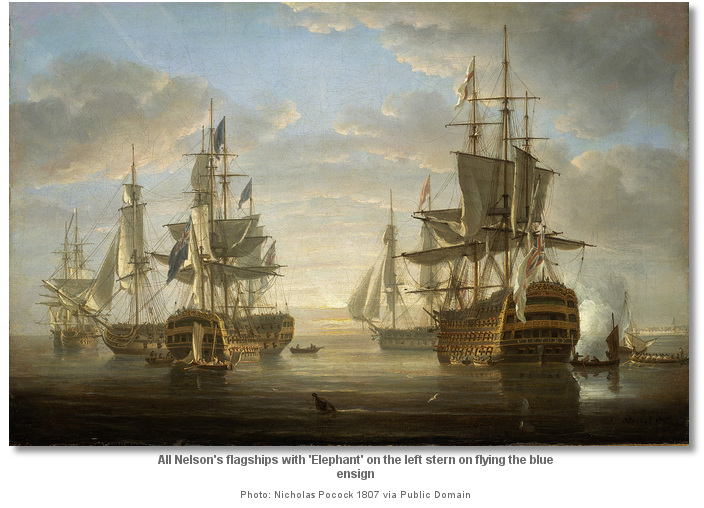
But this was not the case when the master shipbuilder George Parsons was building Elephant at Burseldon. Parsons was born in Poole in 1744, and after being a shipwright in the Royal Dockyard he had worked his way up to leasing the Bursledon yard and later building his own yard at Warsash. Elephant was designed by Sir Thomas Slade as a 3rd rate 74 guns ship and was a timber ship made of Baltic planking. Elephant's dimensions were 168 ft of Gun Deck, a 139 ft 10in Keel, a breadth of 47 ft, a depth of 19 ft 9in, a tonnage of 1617 and she was battle ready with 590 men. In late November 1790 she narrowly avoided destruction when lightning struck her whilst in Portsmouth harbour. The main topmast exploded but did not plunge through the quarterdeck as it was still held by the top-rope. By chance, in 1801, Elephant became Nelson's flagship at the Battle of Copenhagen where she was to become part of the legend that surrounds Horatio Nelson, 1st Viscount Nelson.
The formation of a ‘League of Armed Neutrality’ between the northern powers, Russia, Prussia, Denmark and Sweden in 1800, led to the War of the Second Coalition where Elephant and Nelson would come together. Nominally the league was formed to protect neutral trade at sea and more particularly to enforce free trade with France that was at the time blockaded by the British navy. The British viewed the League as a serious threat that was very much in the French interest and despatched a British fleet of fifty-three vessels, of which eighteen were of the line, to the Baltic in the Spring of 1801. Sir Hyde Parker, an amiable man who was naturally cautious and moved slowly, was given the command of the fleet. He had Nelson with him as his second in command who was then a junior admiral, but Parker was without a rival in his capacity and in his hold on the confidence of the fleet. Arriving off Copenhagen where the Danish fleet were concentrated Sir Hyde Parker was inclined to blockade Denmark and take control of the entrance to the Baltic. Nelson however, a man of action, was tired of manning the French Blockade and urged a pre-emptive attack on the Danish fleet at harbour and Parker went along with it. Before the battle Nelson transferred his flag from the 98-gun HMS St. George as Elephant's shallower draught made her more suitable for the shallow waters around Copenhagen
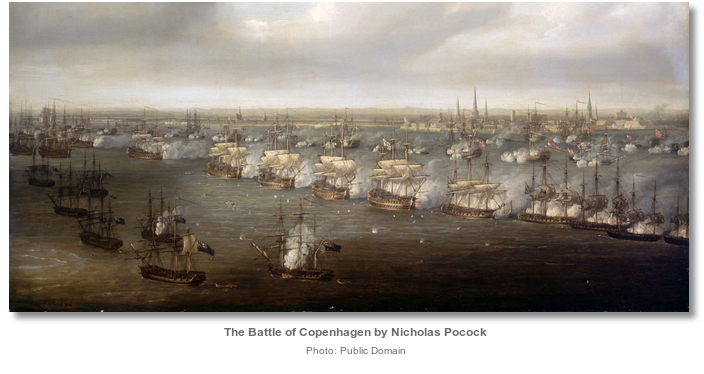
The attack began badly for the British, with HMS Agamemnon unable to round to its required position, HMS Bellona and HMS Russell running aground, and as the wind was from the southeast Sir Hyde Parker was unable to make his proposed attack from the north. The rest of the fleet encountered heavy fire from Copenhagen’s powerful Trekroner, Three Crown, battery at the northern end of the seafront along with the Danes strongest ships that were located there. They pounded each other for two hours and Parker, who saw the danger of Nelson's position, became anxious. He sent his second, Captain Robert Waller Ottway, to him with a message authorising him to retire if he thought fit. Before Ottway, who had to go in a rowboat to reach the Elephant, arrived Parker had reflected that it would be more magnanimous for him to take the responsibility of ordering the retreat. He therefore hoisted the signal of recall reasoning I will make the signal for recall for Nelson's sake. If he is in a condition to continue the action he will disregard it; if he is not, it will be an excuse for his retreat and no blame can be attached to him.
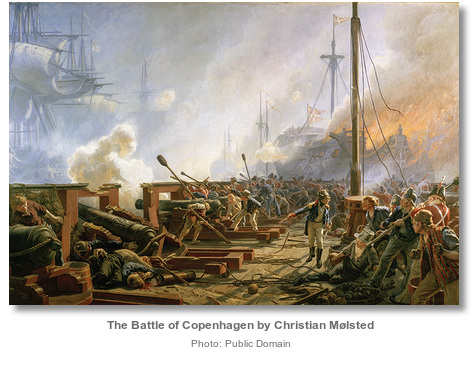

Parker approved of Nelson's actions in retrospect, and Nelson was given the honour of going into Copenhagen the next day to open formal negotiations. At a banquet that evening, he admitted to Prince Frederick, who spoke English, that the battle had been the most severe he had ever been in. The Danish government, which had entered the coalition largely from fear of Russia, was not prepared to make very great sacrifices and were happy to enter into a negotiation for an armistice. In the event the assassination of the tsar Paul in the following days cleared the path for them to sign a fourteen weeks armistice. This left the British fleet free to proceed up the Baltic. Parker was recalled in May and Nelson was made commander-in-chief in the Baltic Sea. As a reward for the victory, he was created Viscount Nelson of the Nile and of Burnham Thorpe. Nelson then sailed to the Russian naval base at Reval, now Tallinn, to find that the pact of armed neutrality was to be disbanded. Satisfied with the outcome of the expedition, he returned to England in July. Copenhagen is often considered to be Nelson's hardest-fought victory, ranked among battles such as the Battle of Trafalgar, as the Danes offered a very stubborn resistance. With the help of Elephant Nelson’s legend was to grow larger and the expression of ‘turning a blind eye’ became a household catch phrase.
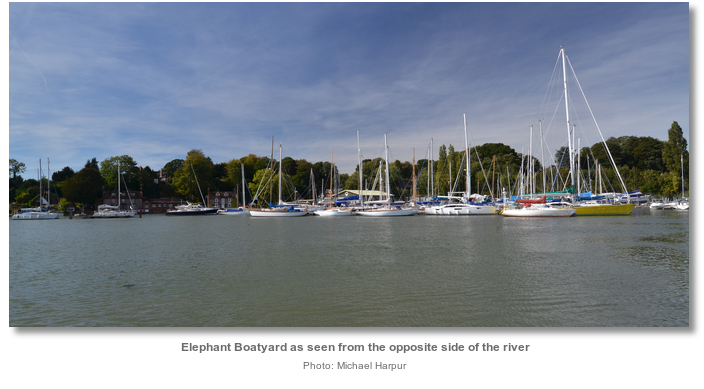
The Elephant Boat yard still builds boats to this day. Since 1952 it has operated as a traditional family business under the custodianship of the Richardson family. It continues to offer a comprehensive service with moorings, slipping and storage for yachts based on the Hamble River and further afield. All their dealings are hallmarked by the charm of old world sailing values. Those intending on staying should provide custom to the Ferry Restaurant, originally a chain link ferry, permanently berthed in the marina. It is the ideal location to take full advantage of the beautiful views in peaceful surroundings whilst enjoying excellent cuisine.
What facilities are available?
The hammerhead is equipped with electricity and water. The boatyard has a highly skilled workforce capable of dealing with most boat repairs, big and small. The large well stocked Force 4 chandlery situated within the yard has almost any part imaginable. Swanwick Marina’s fuel berth is immediately opposite.The Ferry Restaurant is fully-licensed and there are plenty of excellent pubs and restaurants on either side of the river in the immediate vicinity. Swanwick post office across the river is within walking distance of the marina. The closest large supermarket is Tesco, a 20 minute walk at 1.2 miles from the marina, at the top of Hamble Lane.
Located on a bend of the Hamble River, just before the A27 Bridge, road access and parking is very convenient and usually available close to the main gangways. Bursledon railway station, on the West Coastway Line, is a short stroll. It offers an hourly service between Southampton Central and Portsmouth Harbour each day of the week, with additional trains at peak periods.
With thanks to:
Michael Harpur S/Y Whistler. Photography Michael Harpur, Peter Trimming and Richard Leeming.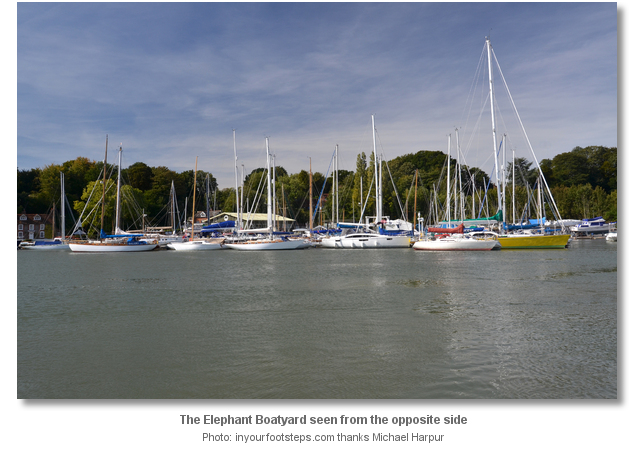
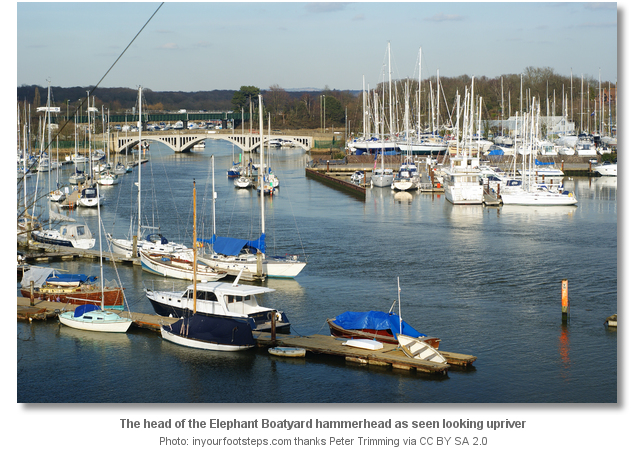

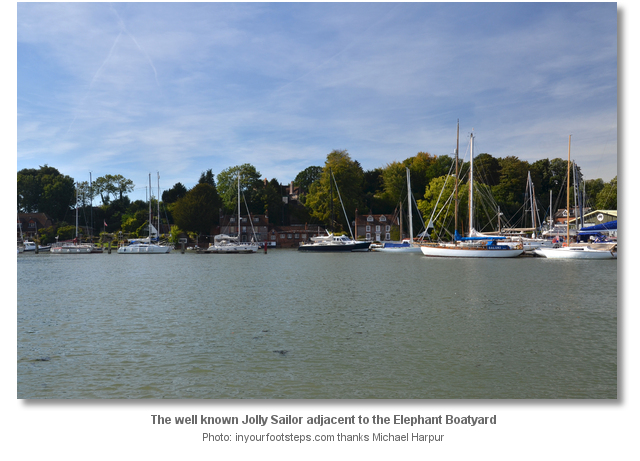
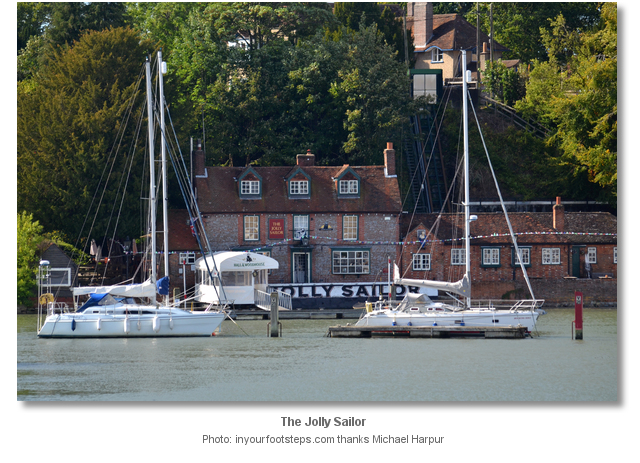
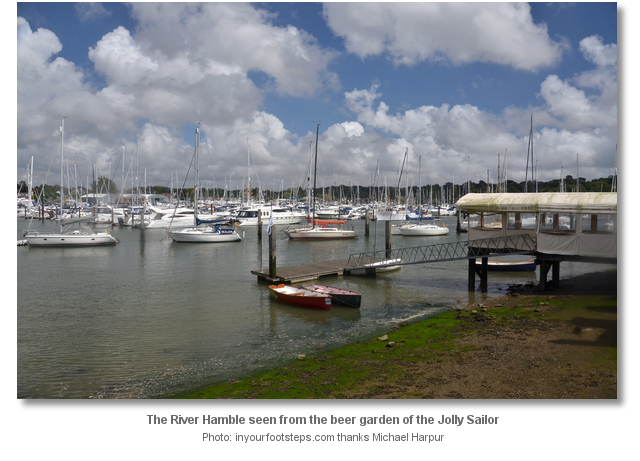
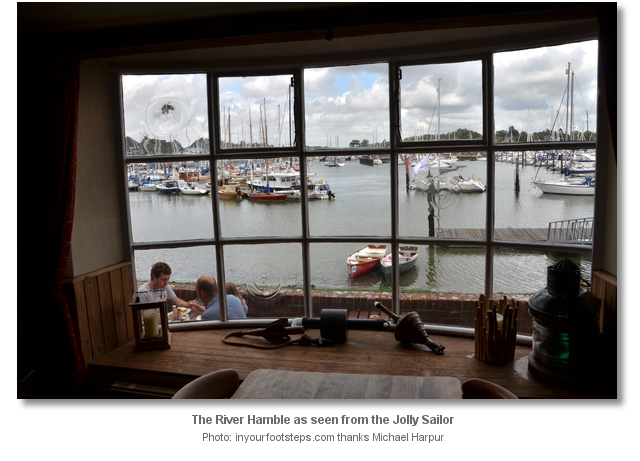
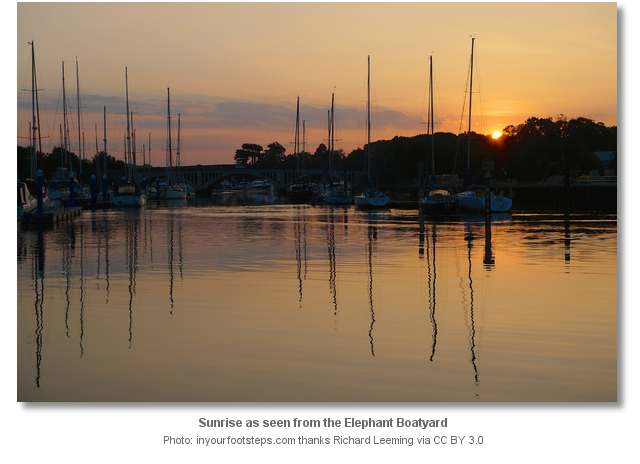
About Elephant Boatyard
Elephant Boat Yard received its name from the later 74-gun third-rate ship of the line of the Royal Navy HMS Elephant. She was built and launched from the boatyard in 1786, and the current boatyard which was founded by Michael Richardson in 1952 on the same site took on the ship’s name to mark the renowned ship’s birth place.
Shipbuilding in the River Hamble however goes back many more centuries before HMS Elephant’s. The river’s sheltered waters, forested banks and ready access to the sea created ideal conditions for the construction of timber ships, and King Henry VIII's fleet was built here. The river’s shipbuilding heyday was in the time of HMS Elephant during the latter half of the 18th century and the beginning of the 19th. Then Elephant was one of forty-six ships that River Hamble provided to the navy during this period. After this the supply of shipbuilding timber began to run low around the river and much of the naval shipbuilding moved to Beaulieu and Lepe where the New Forrest provided a plentiful supply. By then the defeat of Napoleon at Waterloo and the subsequent lack of a French threat for the subsequent decades diminished the need for such vessels.

But this was not the case when the master shipbuilder George Parsons was building Elephant at Burseldon. Parsons was born in Poole in 1744, and after being a shipwright in the Royal Dockyard he had worked his way up to leasing the Bursledon yard and later building his own yard at Warsash. Elephant was designed by Sir Thomas Slade as a 3rd rate 74 guns ship and was a timber ship made of Baltic planking. Elephant's dimensions were 168 ft of Gun Deck, a 139 ft 10in Keel, a breadth of 47 ft, a depth of 19 ft 9in, a tonnage of 1617 and she was battle ready with 590 men. In late November 1790 she narrowly avoided destruction when lightning struck her whilst in Portsmouth harbour. The main topmast exploded but did not plunge through the quarterdeck as it was still held by the top-rope. By chance, in 1801, Elephant became Nelson's flagship at the Battle of Copenhagen where she was to become part of the legend that surrounds Horatio Nelson, 1st Viscount Nelson.
The formation of a ‘League of Armed Neutrality’ between the northern powers, Russia, Prussia, Denmark and Sweden in 1800, led to the War of the Second Coalition where Elephant and Nelson would come together. Nominally the league was formed to protect neutral trade at sea and more particularly to enforce free trade with France that was at the time blockaded by the British navy. The British viewed the League as a serious threat that was very much in the French interest and despatched a British fleet of fifty-three vessels, of which eighteen were of the line, to the Baltic in the Spring of 1801. Sir Hyde Parker, an amiable man who was naturally cautious and moved slowly, was given the command of the fleet. He had Nelson with him as his second in command who was then a junior admiral, but Parker was without a rival in his capacity and in his hold on the confidence of the fleet. Arriving off Copenhagen where the Danish fleet were concentrated Sir Hyde Parker was inclined to blockade Denmark and take control of the entrance to the Baltic. Nelson however, a man of action, was tired of manning the French Blockade and urged a pre-emptive attack on the Danish fleet at harbour and Parker went along with it. Before the battle Nelson transferred his flag from the 98-gun HMS St. George as Elephant's shallower draught made her more suitable for the shallow waters around Copenhagen

The attack began badly for the British, with HMS Agamemnon unable to round to its required position, HMS Bellona and HMS Russell running aground, and as the wind was from the southeast Sir Hyde Parker was unable to make his proposed attack from the north. The rest of the fleet encountered heavy fire from Copenhagen’s powerful Trekroner, Three Crown, battery at the northern end of the seafront along with the Danes strongest ships that were located there. They pounded each other for two hours and Parker, who saw the danger of Nelson's position, became anxious. He sent his second, Captain Robert Waller Ottway, to him with a message authorising him to retire if he thought fit. Before Ottway, who had to go in a rowboat to reach the Elephant, arrived Parker had reflected that it would be more magnanimous for him to take the responsibility of ordering the retreat. He therefore hoisted the signal of recall reasoning I will make the signal for recall for Nelson's sake. If he is in a condition to continue the action he will disregard it; if he is not, it will be an excuse for his retreat and no blame can be attached to him.


Parker approved of Nelson's actions in retrospect, and Nelson was given the honour of going into Copenhagen the next day to open formal negotiations. At a banquet that evening, he admitted to Prince Frederick, who spoke English, that the battle had been the most severe he had ever been in. The Danish government, which had entered the coalition largely from fear of Russia, was not prepared to make very great sacrifices and were happy to enter into a negotiation for an armistice. In the event the assassination of the tsar Paul in the following days cleared the path for them to sign a fourteen weeks armistice. This left the British fleet free to proceed up the Baltic. Parker was recalled in May and Nelson was made commander-in-chief in the Baltic Sea. As a reward for the victory, he was created Viscount Nelson of the Nile and of Burnham Thorpe. Nelson then sailed to the Russian naval base at Reval, now Tallinn, to find that the pact of armed neutrality was to be disbanded. Satisfied with the outcome of the expedition, he returned to England in July. Copenhagen is often considered to be Nelson's hardest-fought victory, ranked among battles such as the Battle of Trafalgar, as the Danes offered a very stubborn resistance. With the help of Elephant Nelson’s legend was to grow larger and the expression of ‘turning a blind eye’ became a household catch phrase.

The Elephant Boat yard still builds boats to this day. Since 1952 it has operated as a traditional family business under the custodianship of the Richardson family. It continues to offer a comprehensive service with moorings, slipping and storage for yachts based on the Hamble River and further afield. All their dealings are hallmarked by the charm of old world sailing values. Those intending on staying should provide custom to the Ferry Restaurant, originally a chain link ferry, permanently berthed in the marina. It is the ideal location to take full advantage of the beautiful views in peaceful surroundings whilst enjoying excellent cuisine.
Other options in this area
Click the 'Next' and 'Previous' buttons to progress through neighbouring havens in a coastal 'clockwise' or 'anti-clockwise' sequence. Alternatively here are the ten nearest havens available in picture view:
Coastal clockwise:
Mercury Yacht Harbour - 0.5 miles SSWPort Hamble Marina - 0.9 miles SSW
Hamble Point Marina - 1.2 miles S
Netley - 1.2 miles SW
Kemps Quay - 2.1 miles WNW
Coastal anti-clockwise:
Deacons Marina and Boatyard - 0 miles NNESwanwick Marina - 0.1 miles SE
Universal Marina - 0.3 miles SSW
Hamble River Harbour Master - 1.1 miles S
Warsash Sailing Club - 1.2 miles S
Navigational pictures
These additional images feature in the 'How to get in' section of our detailed view for Elephant Boatyard.









| Detail view | Off |
| Picture view | On |
Add your review or comment:
Please log in to leave a review of this haven.
Please note eOceanic makes no guarantee of the validity of this information, we have not visited this haven and do not have first-hand experience to qualify the data. Although the contributors are vetted by peer review as practised authorities, they are in no way, whatsoever, responsible for the accuracy of their contributions. It is essential that you thoroughly check the accuracy and suitability for your vessel of any waypoints offered in any context plus the precision of your GPS. Any data provided on this page is entirely used at your own risk and you must read our legal page if you view data on this site. Free to use sea charts courtesy of Navionics.




 +44 23 8040 3268
+44 23 8040 3268 info@elephantboatyard.co.uk
info@elephantboatyard.co.uk elephantboatyard.co.uk
elephantboatyard.co.uk








